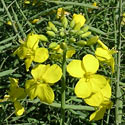|
Food and drink biodiversity:
Vegetable oils and margarine
|
Carthamus tinctorius
(Safflower)
A thistle-like herb with yellow flower heads that
originates from the Middle East. It has been cultivated since ancient times and
is not known from nature. The original main reason for its cultivation was that
the dried flowers yielded a valuable red dye containing the pigment carthamine,
which was used to colour cloth. However, synthetic aniline dyes have taken over.
Nowadays Safflower is cultivated mainly to produce edible oil from the seed-like
fruits. This oil contains the highest levels of linoleic acid (a polyunsaturated
oil) of any seed oil and is used in margarines, salad oils and cooking oil. |
|
Helianthus annuus (Sunflower)yielding: sunflower oil, yellow margarine Sunflowers originate from North America and are now
grown extensively for their seeds which produce vegetable oil that is used in
cooking, salad oils and margarines. The residue after oil extraction provides a
high protein food source for livestock. |
|
|
Brassica napus
(Rape, Oilseed rape, Canola)
Brassica napus is native to Eurasia and has a
number of varieties that are cultivated widely round the world for the
production of vegetable oil. Canola is a variety of Brassica napus developed in Canada that
contains low concentrations of erucic acid and glucosinolates and the name is
derived from the words CAnadian Oilseed Low_Acid. It is grown
mainly for the production of cooking oil and Canola margarine, and has been
cultivated in South Africa since 1994. |
 |
Olea
europaea (Olive)
yielding: olive oil |
|
|
